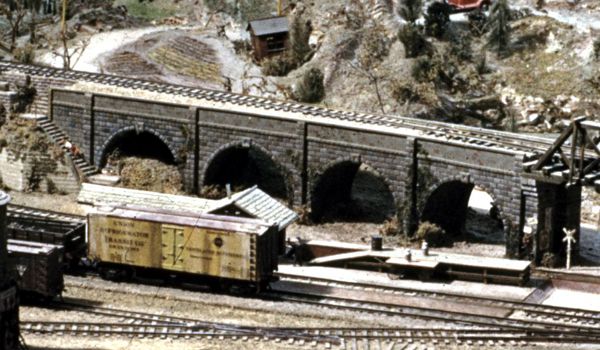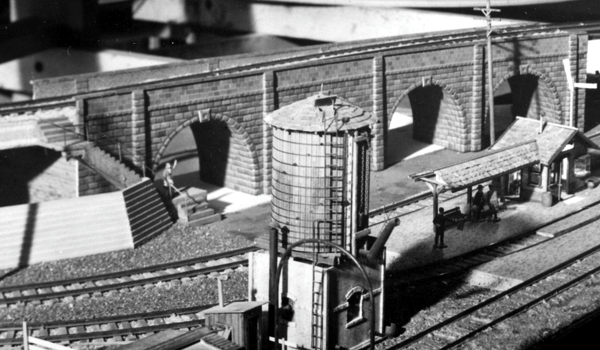The Viaduct
As was the case with the wooden truss bridges, the stone viaduct on the Gorre & Daphetid presents many questions to answer. Indeed, once again there are issues to resolve with both the design and execution of the Z scale adaptation. Because of the different track geometry involved, some artistic license will have to be taken.

Before getting into the particulars, however, there's a third aspect that comes into play: aesthetics. I'd always felt the stonework of John Allen's viaduct was too "clean" or "high-end" for the likes of the rinky-dink G&D; to me, it doesn't fit with the rustic wooden truss bridges that it abuts. With this in mind, I may take more liberties with the viaduct than I might with the two iconic wooden bridges, much as it may rub purists the wrong way.

Aesthetics aside, fitting a viaduct in the space requires one of two compromises: making smaller arches, or making three of them instead of four. Note how a scaled image of the viaduct doesn't fit the space properly (above); this is due in part to the fact that the bridge track must be higher for the Z scale adaptation, relative to the HO original, owing to different clearance requirements. Complicating matters, John's viaduct is gently curved; I may straighten mine out just to make construction easier. I've determined four options:
Option 1. Use John's own construction technique, which I believe is printed paper laminated on heavy cardstock, thin wood or other substrate (the early construction photo below provides some clues). This would allow me to mimic its appearance very closely; however, it might entail considerable work generating art that's even similar, let alone identical. Also, printed paper may look great in photographs, but it rarely impresses as much in person.

Option 2. Chooch's first-generation N scale stone portals are actually undersized for N, and are much closer to Z. I've made viaducts from cast stone portals before, so I know it works, and the more rustic style exactly suits what I saw in my mind's eye for my adaptation of the viaduct. Plus, I have dozens of portals on hand. The downside is the stonework: the arches might be right, but the stone size is pretty hefty for Z scale.
Option 3. Make my own stone masters and cast them to make a totally custom viaduct. This offers the best of all worlds: sized to exactly fit the space, and styled to exactly suit my aesthetic preferences. The downside ought to be obvious: it would be a ton of work. Making stone masters is incredibly labor-intensive; it could consume several full days of time, when one of my goals has been to be as time-efficient as possible.
Option 4. Bash a plastic kit. This would be the quickest and easiest by far, but there's an availability issue: the Kibri kits are actually N/Z, and thus too large, whereas the true Z scale Faller kits are long discontinued. If I could locate two of the Faller straight stone viaduct kits, it would be my choice. I happen to have one of the curved kits, so I know the size is perfect, as can be seen below; alas, the curvature is too tight, and the kit has only three arches.

And so the problem-solving continues side-by-side with construction. I may have to take a break from hardcore modeling, however, as I've injured one of my fingers rather badly in a stupid blunder. Modeling with only one functional index finger is rough—so's typing, for that matter!
Original Gorre & Daphetid images courtesy of Peter T. Prunka.
